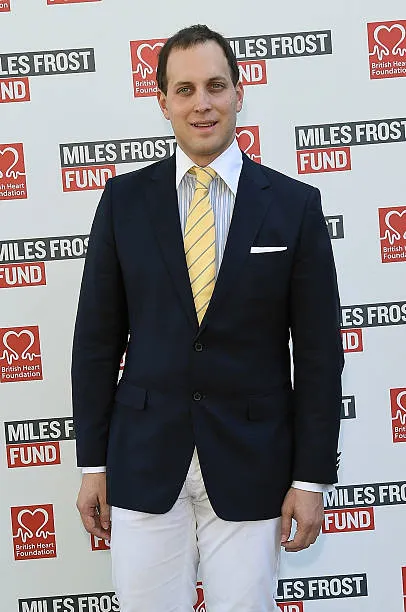While Lord Frederick Windsor may be 50th in line to the British throne, the son of Prince and Princess Michael of Kent has long demonstrated that his passions extend far beyond the traditional duties of the royal family. A keen and accomplished photographer, Lord Frederick has quietly carved a name for himself in the art world, using his camera to capture a distinct and personal view of the world around him. Through his work, he offers a rare glimpse into his creative soul, displaying an eye for detail and a technical prowess that is remarkable given the more traditional expectations placed upon his position in the monarchy.
Unlike other royals who have pursued more conventional paths, Lord Frederick’s artistic journey is one of genuine dedication. His photography has been exhibited at various galleries and events, allowing the public to engage with his work in a way that transcends his royal status. His exhibitions, though not as widely known as the works of more famous photographers, provide a unique and thoughtful perspective on the world, as captured through his lens.
However, the precise nature of Lord Frederick’s artistic approach is not easily defined. Unlike some photographers, who might become known for a specific style or subject, Lord Frederick’s work resists simple categorisation. While details about his preferred photographic subjects remain somewhat elusive, this only adds to the intrigue surrounding his artistic pursuits. Does he focus on portraiture, seeking to capture the emotional depth and humanity of his subjects? Or perhaps he is drawn to the tranquillity of landscapes, with an eye for light, composition, and the interplay between natural elements? There is no definitive answer, yet this ambiguity creates an allure for those who seek to understand the breadth of his creative vision.
What is evident, however, is that Lord Frederick approaches his photography with the same quiet diligence and dedication that he applies to all areas of his life. Despite his royal lineage, which might dictate a more public-facing life filled with ceremonial duties, he has chosen instead to invest his time and energy into something far more personal: his art. Photography has become his chosen medium for self-expression, a way for him to quietly break free from the constraints of his royal status and make a statement on his own terms. The fact that he has pursued this passion with such focus and seriousness speaks to the depth of his commitment to the craft.
Navigating the dual worlds of royal responsibilities and artistic expression is undoubtedly a delicate balancing act. On the one hand, Lord Frederick must adhere to the expectations placed on him as a member of the British royal family. On the other, he has created space for himself within the world of art and photography, allowing his creativity to flourish in ways that many may not have anticipated. He stands as a testament to the idea that tradition and personal passion can coexist—though this balance is often a challenge for those born into royal life.
His work also demonstrates the ways in which photography, often perceived as an accessible art form, can transcend societal boundaries and provide a deeply personal means of expression. In a world where the royal family is often defined by its duty to public service, Lord Frederick’s creative pursuits allow him to step beyond the public gaze and create something truly his own. Through his lens, he invites us to see the world from his unique point of view—one that is not defined by his birthright, but by his artistic sensitivity and technical skill.
In this sense, Lord Frederick’s journey as a photographer represents much more than just a hobby or a fleeting interest. It is a genuine exploration of the artistic process, an attempt to understand and make sense of the world, and to communicate that understanding with others. Whether through portraits, landscapes, or abstract photography, his work reveals his thoughtful and contemplative nature. It demonstrates a man who, despite being a royal figure, chooses to engage with the world in a way that is distinctly his own. This is an important lesson in itself: that one can be bound by tradition, yet still find room to express individuality and creativity.
As his artistic journey continues to unfold, it will be fascinating to see where Lord Frederick’s photography takes him. Will he expand his portfolio to include new subjects and themes, or will he continue to refine his existing body of work? What is certain is that his photographic practice is evolving, and with each new exhibition, we are offered a deeper insight into his creative soul.
For those who may only know Lord Frederick Windsor as a royal figure, his work offers a refreshing and valuable perspective. It shows that creativity is not bound by one’s position in society or family, but rather is a personal journey that can be pursued regardless of background or expectation. Lord Frederick’s work offers us a unique opportunity to reflect on the power of art and the role it can play in transcending both personal and societal boundaries.
In an era where the pressures of public life often seem to stifle personal expression, Lord Frederick Windsor stands as a quiet, yet powerful, example of how the pursuit of art can not only thrive within a royal context, but enrich it. His photography challenges us to think about the world differently, to appreciate the beauty in the everyday, and to recognise that artistry, in all its forms, is something that should be celebrated, regardless of one’s station in life. As his journey continues, Lord Frederick Windsor remains a testament to the power of creativity, individuality, and the enduring human desire to capture and interpret the world around us.
